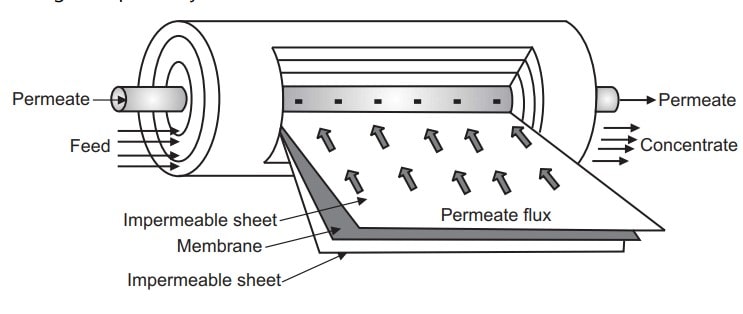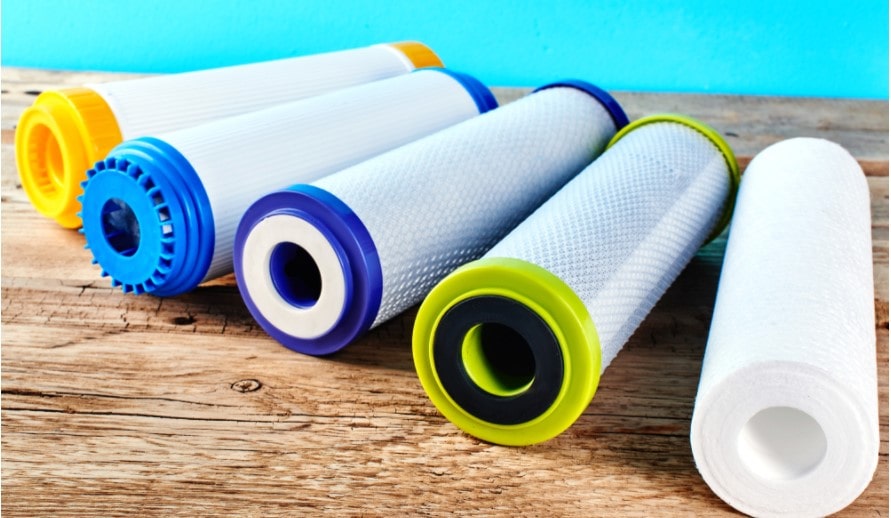A membrane, or membrane filter, is a thin layer of semi-permeable material that separates substances when a driving force is applied across the membrane. It works on the principle of physical separation. These are used for the removal of bacteria, micro-organisms, particulates, and natural organic material, which can impart color, tastes, and odors to water and react with disinfectants to form disinfection byproducts. Advancements are made in membrane production and module design with the view of reducing capital and operating costs. The membrane processes include:
(i) Microfiltration
(ii) Ultrafiltration
(iii) Nanofiltration
(iv) Reverse osmosis
Table of Contents
Construction of a Membrane Filter
Membrane filters are plastic membranes based on cellulose acetate, cellulose nitrate, or mixed cellulose esters with pore sizes in the micron or submicron range. They are very thin, about 120, µ and must be handled carefully. They act like a sieve, trapping particulate matter on their surface. Several grades of filters are available with pore sizes ranging from 0.010 ± 0.002 µ to 5.0 ± 1.2 µ. Type codes VF and SM are given by Millipore Filter Corp. for these two extreme ranges, respectively.

Filters with pore sizes from 0.010 to 0.10 µ can remove virus particles from water or air. Filters with pore sizes from 0.30 to 0.65 µ are employed for removing bacteria. Filters with the larger pore sizes, viz. 0.8, 1.2, and 3.0 to 5.0 µ are employed, for example, in aerosol, radioactivity, and particle sizing applications. Membrane filters are manufactured as flat sheet stock or as hollow fibers and formed into several different types of membrane modules. Module construction involves potting or sealing the membrane material into an assembly, such as with a hollow-fiber module. These types of modules are designed for long-term use over the course of a number of years. Spiral-wound modules, Figure is shown below, are also manufactured for long-term use.
Working of a Membrane Filter
The membrane separation process is based on the presence of semi-permeable membranes. The principle is membrane acts as a very specific filter that will let water flow through, while it catches suspended solids and other substances. During use membrane filters are supported on a rigid base of perforated metal, plastic or coarse sintered glass as in the case of fibrous pad filters. If the solution to be filtered contains a considerable quantity of suspended matter, preliminary filtration through a suitable depth filter avoids clogging of the membrane filter during sterile filtration. They are brittle when dry and can be stored indefinitely in the dry state but are fairly tough when wet.
(i) Microfiltration (MF): Microfiltration is defined as a membrane separation process using membranes with a pore size of approximately 0.03 to 10 µ, a molecular weight cut-off (MWCO) of greater than 10,00,000 Daltons and relatively low feed water operating pressure of approximately 100 to 400 kPa (15 to 60 psi). Sand, silt, clays, Giardia lamblia, and Crypotosporidium cysts, algae, and some bacterial species are removed by MF. This filter is not an absolute barrier to viruses but when used in combination with disinfectant it appears to control them. There is a growing emphasis on limiting the concentrations and number of chemicals that are applied during water treatment. By physically removing the pathogens, membrane filtration can significantly reduce chemical addition, such as chlorination. It can also be used to remove natural-synthetic organic matter to reduce fouling potential. The pretreatment helps to increase the removal of organic material. MF can also be used as a pretreatment to reverse osmosis (RO) or Nano-filtration (NF) to reduce bad odor as well as to remove hardness from groundwater.
(ii) Ultrafiltration (UF): The ultrafilters have a pore size of approximately 0.002 to 0.1 µ, with an MWCO of approximately 10,000 to 100,000 Daltons, and operating pressure of approximately 200 to 700 kPa (30 to 100 psi). It removes all microbiological species such as partial removal of bacteria, as well as humic materials and some viruses but is not an absolute barrier to viruses. Disinfection can provide a second barrier to contamination and is therefore recommended. The primary advantages of low-pressure UF membrane processes are :
(i) No need for chemicals (coagulants, flocculants, disinfectants, pH adjustment).
(ii) Size-exclusive filtration.
(iii) Constant quality of the treated water in terms of particle and microbial removal.
(iv) The process and plant are compact.
(v) Simple and automatic, however, fouling can cause difficulties in membrane technology for water treatment.
(iii) Nanofiltration: Nanofiltration membranes have a nominal pore size of approximately 0.001 µ and an MWCO of 1,000 to 100,000 Daltons. Pushing liquid through these very small size membrane pores requires a higher operating pressure. Operating pressures are usually near 600 kPa and can be as high as 1,000 kPa. NF can apparently remove all cysts, bacteria, viruses, and humic materials. They provide excellent protection from disinfection by-product (DBP) formation (if the disinfectant residual is added) and remove alkalinity. NF also removes hardness from water, which accounts for NF membranes sometimes being called “softening membranes.” Hard water treated by NF needs pretreatment to avoid precipitation of hardness ions on the membrane.
Reverse Osmosis (RO):
Reverse osmosis can effectively remove nearly all inorganic contaminants from water. It can effectively remove radium, natural organic substances, pesticides, cysts, bacteria, and viruses. It is particularly effective when used in series with multiple units. Disinfection is also recommended to ensure the safety of the water. Advantages of this filter include the removal of nearly all contaminant ions and most dissolved non-ions. It is relatively insensitive to flow and total dissolved solids. It operates immediately without any minimum break-in period. It is possible to concentrate effluents with low solid. It is capable of removing bacteria and particles. The operational simplicity and automation features allow for less supervision.
Limitations
(i) High capital and operating costs.
(ii) Managing the wastewater (brine solution) is a potential problem.
(iii) High level of pretreatment is required in some cases.
(iv) Membranes are prone to fouling.
(v) Produces the most wastewater at between 25-50 % of the feed.
Advantages of a Membrane Filter
(i) Filtration rate is rapid.
(ii) They are disposable and hence no cross-contamination takes place.
(iii) No bacterial growth through the filter takes place during prolonged filtration.
(iv) Adsorption is negligible they yield no fibers or alkali into the filtrate.
Disadvantages
(i) Ordinary types are less resistant to solvents like chloroform.
(ii) They may clog though rarely.
Applications
(i) It allows the isolation and categorization of micro-organisms.
(ii) It is used in the removal of ammonium ions from potable water.
(iii) Dairy industry: MF is a valuable part of the manufacture of dairy ingredients. It has applications in milk, whey, and clarified cheese brine.
(iv) Starch and sweetener industry: It can be used to increase the performance of the products, for example, clarification of corn syrups such as dextrose and fructose, the concentration of rinse water from starch, the enrichment of dextrose, the depyrogenation of dextrose syrup and the division/concentration of maceration water.
(v) Sugar industry: MF can be used to clarify unprocessed juice without using primary clarifiers. It can be used to clarify, divide and concentrate various sugar solutions in the production process.
(vi) Chemical industry: MF can be used in many chemical processes to desalinate dial filter and purify dyes, pigments, and optical brighteners, to clean the wastewater and rinse water currents, for the concentration and dehydration of minerals such as kaolin clay, titanium dioxide, and calcium carbonate, the clarification of caustic agents and the production of polymers or the recuperation of metals.
(vii) Pharmaceutical industry: It is used in the harvesting of cells or the recuperation of biomass in the process of fermentation during the manufacturing of antibiotics. MF improves production as well as reduces labor and maintenance costs. It is used in the industrial production lines for enzymes in concentrating them prior to other processes.
Also read : Equipment used in the filtration process
